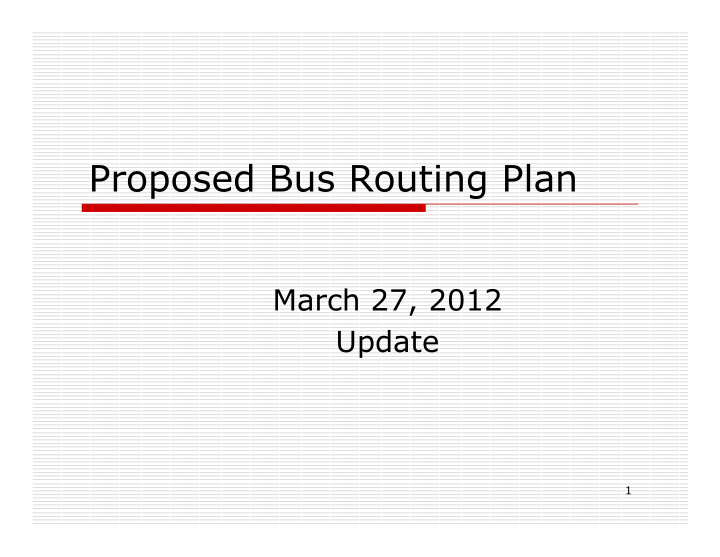



Proposed Bus Routing Plan March 27, 2012 Update 1
Overview of Discussion: Comprehensive study Why review and change the transportation system? The proposed new plan Benefits of proposed plan Impact of proposed plan An alternate proposal Q&A 2
Comprehensive Study: First phase: Two-tier transportation system Second phase: Evaluate inefficient magnet school transportation Third Phase: Evaluate high school schedules 3
Why Review and Change the Transportation System? Current transportation system: Instituted in mid 1990s Three tiers Only 45 minutes to leave one school, pick-up riders and drive to next school Not feasible to increase time between tiers 4
Why Review and Change the Transportation System? (continued) Buses often are late: Not providing level of service customers should expect 19% of later tier buses are not on-time Inconsistent bus schedule impacts family routines District offices cannot field all calls about late buses=parent frustration 5
Why Review and Change the Transportation System? (continued) Bus drivers are stressed to be on- time Does this impact accident rate? Bus driver recruiting & retention: Historically 30-50 vacant positions High standards Rigorous training requirements Tough hours & low rate of pay 6
Why Review and Change the Transportation System? (continued) Fiscal concerns: Growth =1,800 more riders Very tight WCPSS budget year $3 million reduction in state funding: WCPSS was model of efficiency, but now other systems are catching up 7
The Proposed Two-Tier Plan: Changes most districts and schools to two-tier system Very few schools on middle tier 112 fewer buses on the road, and…. Net of 60 fewer after growth and assignment plan are accounted for Requires about ¼ of schools to change daily schedule 8
Benefits of Proposed Plan: Buses will be on-time to all schools in morning and afternoon Fewer buses = less cost More students per bus = greater efficiency Greater efficiency = state funding restored Proactive rather than reactive management 9
Benefits of Proposed Plan (Cont.): Less stress on drivers to meet tight schedule Reduced accident risk No drivers will lose jobs Reduces driver vacancies Far fewer double-backs/combined routes Substitutes will be available when drivers are absent 10
Impacts of Proposed Plan: 39 schools’ daily schedule must be changed by more than 30 minutes Students’ average ride time may increase from 17 minutes to 22-24 minutes, but Longest ride times should be reduced Families would have to adapt daily schedules Superintendent Tata directed staff to consider before and after care options 11
An Alternate Proposal: We listened to parents’ feedback! Propose a “Two-tier Light” system Differences from original proposal: No school changes by more than one tier Several elementary schools’ bell times swapped to avoid changes The alternate proposal changes only 33 schools by 30+ minutes 12
Alternate proposal: Green ES, Wendell ES and Zebulon ES start at 8:30 (original proposal was for a 2 tier change, now a 1 tier change) Davis Drive ES stays on 1 st tier & rides with Davis Drive MS Briarcliff ES and Kingswood ES stay on current bell schedule instead of switching tiers Sycamore Creek ES, Leadmine ES and Lincoln Heights ES stay on 8:30 bell schedule Original proposal + above = alternate proposal Reduces gross bus savings from 112 buses to 79, and reduces net savings from 60 buses to 27
Comparison of Proposals (2012-13): Three-Tier Two-Tier Two-Tier Light System Proposal Proposal Late buses 147+ 0 0 Tier changes 0 4 0 >1 Average ride 16 22-24 22-24 time (minutes) Net bus change +52 -60 -27 Net business $4 million -$2 million -$.8 million cases Driver 50 today+ 52 0 50 today-27 vacancies =102 =23 14
Questions: 15
Recommend
More recommend